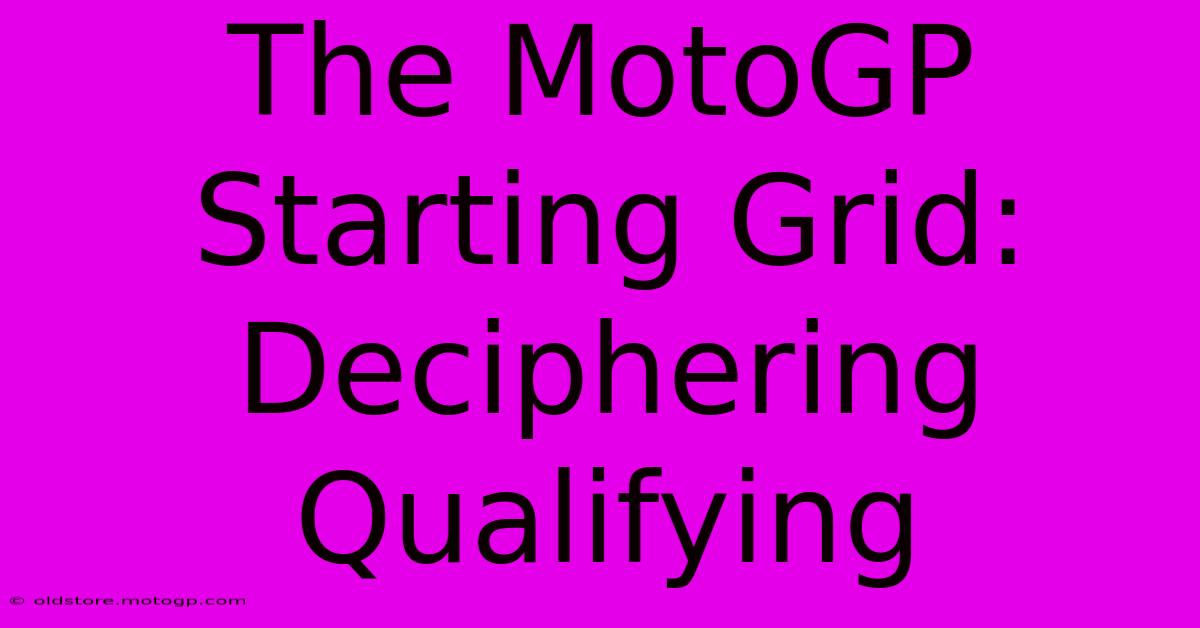The MotoGP Starting Grid: Deciphering Qualifying

Table of Contents
The MotoGP Starting Grid: Deciphering Qualifying
MotoGP, the pinnacle of motorcycle racing, isn't just about the race itself; a significant portion of the drama unfolds during qualifying. The starting grid, determined by the outcome of qualifying, dramatically influences the race's outcome. Understanding how qualifying works is crucial for any serious MotoGP fan. This article delves into the intricacies of MotoGP qualifying, explaining the different sessions, the strategies employed, and the factors that contribute to a rider's grid position.
Understanding the Qualifying Format
MotoGP qualifying isn't a single session; it's a multi-stage process designed to separate the fastest riders from the rest of the pack. The format might seem complex at first glance, but breaking it down reveals a clear strategy behind each stage.
Q1: The Fight for Q2
The first qualifying session, Q1, features the riders who didn't finish within the top 10 in the combined Free Practice times (FP1, FP2, and FP3). This session is a high-stakes battle; only the two fastest riders from Q1 progress to Q2. The remaining riders are locked into their starting positions based on their Q1 times. This session is often characterized by intense wheel-to-wheel racing as riders push their machines to the absolute limit to secure a place in the crucial Q2. Strategic tire choices and race simulations are vital elements of success here.
Q2: The Quest for Pole Position
Q2 brings together the top 10 riders from the combined Free Practice sessions and the two fastest from Q1. This is where the real drama unfolds. This 12-rider session decides the front two rows of the starting grid, with the fastest rider securing pole position – the coveted spot at the very front of the grid. The fight for pole is ferocious, with riders constantly trying to improve their lap times by even fractions of a second. Slipstreaming and perfect track conditions are key elements in achieving a fast lap time during this session.
Factors Affecting Qualifying Performance
Several factors influence a rider's performance during qualifying, beyond just raw speed.
The Bike's Setup: A perfectly tuned machine is paramount. The team mechanics work tirelessly throughout the weekend to optimize the bike's settings for the specific track conditions. Even minor adjustments can significantly impact lap times.
Tire Choice: Selecting the right tire compounds is critical. Soft compound tires provide the fastest lap times, but they degrade quickly. Riders must balance speed with tire longevity, especially when considering the race's length.
Track Conditions: Temperature, humidity, and even the presence of wind can dramatically affect grip and overall performance. Riders and teams must constantly adapt to changing conditions.
Rider Skill and Experience: Qualifying is a test of precision, skill, and nerve. Experienced riders can often extract more performance from their machines and manage their tire wear more efficiently.
Team Strategy: A successful qualifying performance often hinges on the team’s strategy. This includes the allocation of track time, tire choices, and feedback between rider and mechanics. Pit stop practice and preparation play a significant role.
The Importance of Starting Position
The starting grid's significance cannot be overstated. A front-row start provides a massive advantage, especially at tracks where overtaking is difficult. A good starting position allows riders to avoid early-race chaos, control the race pace, and conserve energy. Conversely, a poor starting position can severely hinder a rider's chances of winning, requiring them to fight their way through the pack and potentially damaging their machine in the process.
Conclusion: More Than Just a Warm-up
MotoGP qualifying is far more than just a warm-up for the race. It’s a crucial part of the weekend, setting the stage for the main event. Understanding the qualifying format, the factors influencing performance, and the importance of starting position provides a much deeper appreciation of the skill, strategy, and drama that defines MotoGP racing. Analyzing qualifying gives insight into the potential race outcomes and helps predict who will dominate on race day. It’s a critical element of the entire MotoGP experience, adding another layer of excitement for fans and a challenge for the riders.

Thank you for visiting our website wich cover about The MotoGP Starting Grid: Deciphering Qualifying. We hope the information provided has been useful to you. Feel free to contact us if you have any questions or need further assistance. See you next time and dont miss to bookmark.
Featured Posts
-
Austin F1 Transportation Options For Out Of Towners
Feb 23, 2025
-
F1 Event Houston The Heart Of Racing
Feb 23, 2025
-
Cota Qualifying The Calm Before The Storm
Feb 23, 2025
-
Yamaha V4 Moto Gp A Legacy Of Championship Wins
Feb 23, 2025
-
Moto 2 Bike Specs The Quest For Speed And Performance
Feb 23, 2025
